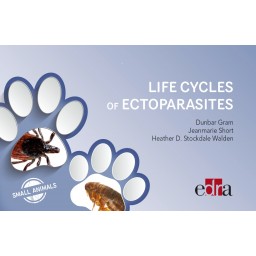



Small handbook gathering all the life cycles of the most common ectoparasites in dogs and cats. Similar parasites are grouped together based on their life cycle and, consequently, their sensitivity to parasiticides. The aim is to provide readers with key aspects of parasite control and prevention, highlighting those diseases that can be transmitted by them. Geographic distribution maps are also included.
Small handbook gathering all the life cycles of the most common ectoparasites in dogs and cats. Similar parasites are grouped together based on their life cycle and, consequently, their sensitivity to parasiticides. The aim is to provide readers with key aspects of parasite control and prevention, highlighting those diseases that can be transmitted by them. Geographic distribution maps are also included.
Authors:
Dunbar Gram
DVM, DACVD, MRCVS
Dr. Gram is Service Chief and Clinical Associate Professor of Dermatology at the University of Florida, College of Veterinary Medicine. He received his undergraduate degree from Wesleyan University in Connecticut and his Doctor of Veterinary Medicine with high honors from Auburn University. He completed an internship at the University of Illinois and a residency in dermatology at North Carolina State University. He has taught dermatology at The University of Edinburgh, The University of Prince Edward Island and North Carolina State University.
Jeanmarie Short
DVM, DACVD
Jeanmarie Short was a licensed veterinary technician before graduating from the Virginia-Maryland Regional College of Veterinary Medicine. She completed a one year rotating internship in emergency and internal medicine. After three years in general small animal practice, she completed a residency in dermatology at Animal Allergy and Dermatology in Virginia Beach, VA, and is now a Board Certified Veterinary Dermatologist. Her interests are in endocrine and allergic diseases.
Heather D. Stockdale Walden
MS, PhD
Dr. Walden is Assistant Professor of Parasitology (Department of Comparative, Diagnostic and Population Medicine) at the University of Florida, College of Veterinary Medicine. She is a member of the American Association of Veterinary Parasitologists (AAVP), and American Society of Parasitologists (ASP). She manages the diagnostic parasitology service in the UF-CVM Parasitology Lab and offers consultation and diagnostic assistance to the Clinical Microbiology, Parasitology and Serology Service in the UF-CVM Small Animal Hospital. Dr. Walden’s research interests focus on zoonotic parasitic disease, diagnosis and classical parasite biology, modes of transmission and pathogenicity in the definitive host. She has lead and collaborated with several research projects throughout the United States, Mexico, Ecuador, the Galapagos Islands, and Zambia and Senegal, Africa.
Table of contents:
1. Introduction
General importance of parasites Importance of life cycles in parasite control
2. Ticks
Description and geographic distribution
Hard ticks
Soft ticks
Life cycle
Hard ticks
Soft ticks
Vector potential and disease transmission
Critical points for control and prevention
3. Fleas
Description and geographic distribution
Life cycle
Host component of flea life cycle
Environmental component of flea life cycle
Vector potential, disease transmission, and economic impact
Critical points for control and prevention
4. Mites
Description and geographic distribution
Demodex mites
Critical points for diagnosis, control, and prevention
Scabies mites
Critical points for diagnosis, control, and prevention
Otodectes cynotis/Ear mites
Critical points for diagnosis, control, and prevention
Cheyletiella spp./“Walking dandruff”
Critical points for diagnosis, control, and prevention
5. Chewing and sucking lice
Description and geographic distribution
Life cycle
Vector potential and disease transmission
Critical points for control and prevention
6. Biting flies
Biting midges (Ceratopogonidae)
Description and geographic distribution
Life cycle
Vector potential and disease transmission
Sand flies (Psychodidae)
Description and geographic distribution
Life cycle
Vector potential and disease transmission
Critical points for control and prevention
7. Mosquitoes
Description and geographic distribution
Life cycle
Vector potential and disease transmission
Critical points for control and prevention
8. Screwworm flies
Description and geographic distribution
Life cycle
Health concerns
Critical points for control and prevention
9. Conclusion
Further reading references
Data sheet
Specific References